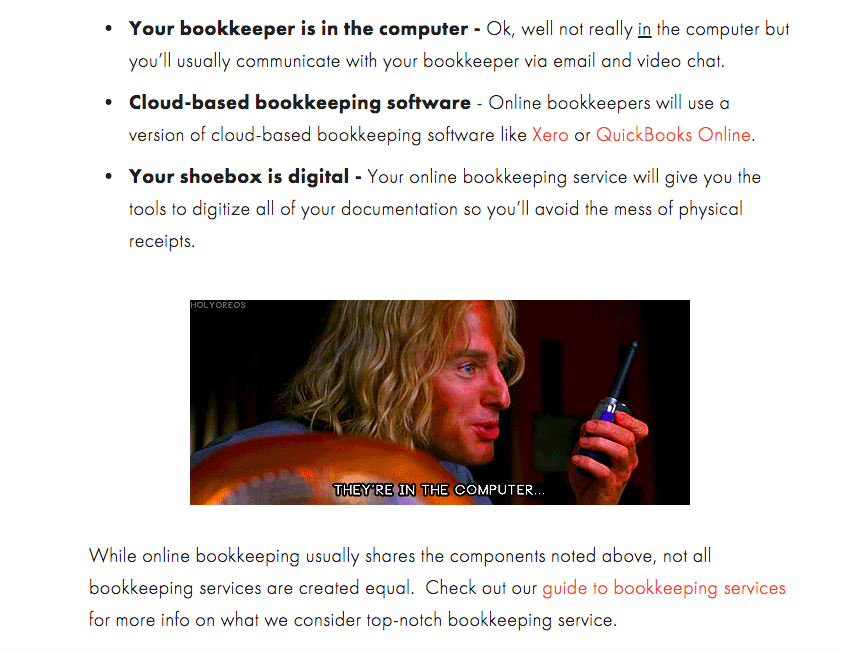
We’re big fans of Marcus Sheridan’s ‘They Ask, You Answer’ principle (you may have heard us say this one or two or forty times already). Your clients have questions they need answered in order to trust that you’re for real before they buy. The purpose of your content is to answer those questions.
When we write content for our clients, it may seem like we’re the ones doing the answering, and therefore the content belongs to us. We’ve been asked a number of times lately whether we should be credited for the content we provide as part of our service.
It’s a great question, and one that opens up a broader conversation about who to credit when, and how to represent your brand no matter who is responsible for doing the writing. You, your team, or the outsourced writers.
All the content created for you belongs to your brand
Today I, Camilla, am writing the PF marketing tip. Hello! I may tell a story to help you connect with the key messages in this blog. I might even pop in a personal anecdote. But I’m still writing on behalf of PF. The PF brand dictates the way I communicate with you.
The same applies when I’m writing content for a client. Their brand (who they are, who they serve, how they serve) dictates the way I pull together what is being communicated to their clients.
What we’re doing for our clients is ghostwriting. (WoooOOoooOOooo)
Spooky to be talking about ghostwriting the morning after Halloween, when some of us are only just recovering from the sugar-fuelled excitement and copious hallo-wine.
(Thanks for finding time to read this between working and organising WHAT ON EARTH you’re going to do with all that pumpkin pulp).
A ghostwriter is like a silent partner in the content creation process. Unlike a guest post where you feature a blog written by another thought leader intentionally, a ghostwriter provides you with content without taking credit – because the content (and therefore all the credit) belongs to the brand.
So who gets the credit when you’re writing in-house?
To ‘We’ or not to ‘We’, that is the (first) question
The kind of firm you are will dictate who to credit and how to communicate as your brand.
- If you’re a firm of one – One of the aims of writing content is to build trust with your potential buyers. In ‘Building a Storybrand’ Donald Miller’s states “Confusing is losing”. If your firm is only made up of you, don’t confuse people by writing “We do XYZ”. It’ll create the impression your firm is a lot bigger than it is, and is likely to leave the buyer feeling deceived.
- If you’re a firm of many – You’re in a better position to share content on behalf of the whole team, as a ‘We’ collective. But don’t be afraid to have different staff members share content as themselves. Showcase the team, their knowledge and their own client stories. You’ll notice we do this – the PF marketing tips now come from a different team member each week. (They used to all be written by Karen, who now writes her own ‘Karen’s Notes’ and it’s clear they’re hers, with her sketchnotes. You can see those here.).
Language and tone of voice is the key to consistency, no matter who is writing the content
You need to know and document how to communicate, to make sure anyone and everyone can write on behalf of the brand.
I’ve separated language from tone here, because there’s a little difference – though both are equally important.
Language: Identify the words and phrases you will and won’t use at your firm, and also identify the words and phrases your target audience uses.
Tone: Your tone is how your personality or attitude is presented in your words. Remember when your Mum used to tell you to “Watch your tone” when you were pushing the sarcasm boundaries a little too far as a kid? (Me neither, because I was a saint). The point is, tone isn’t just about the words you use, it’s how you use them.
We recommend creating a style and tone of voice document to share with your in-house or outsourced writers. Here’s an example of what that can look like.
If you haven’t put much thought to what your style and tone of voice is, here’s a little starter pack of three questions to ask yourself:
1. How do you talk to each other internally?
Thinking about your culture of communication is a great way to start. What is acceptable at your firm and what isn’t?
- At PF, we may drop the occasional F-bomb internally, but it’s not really our way of doing things. So it wouldn’t make sense for us to be overly sweary in our content.
- We’re avid believers in a good GIF in-house, so we’re not averse to sharing GIFs with our clients when the moment calls for it.
Here are some examples of clients manifesting their own internal talk. I love these!
- “Bloody great with people” is word for word how the guys at Golding described themselves:

- Our friends at Avalon showing that their GIF game is strong, and letting lightheartedness and humour shine through their content.
 2. If your brand was a person, what personality would they have?
2. If your brand was a person, what personality would they have?
You always want to have your firm’s core values in mind when you’re representing your brand. Period. Our personalities are often a reflection of our values, so this question will help you think a little more about how you live and breathe those values in your content. Remember, the purpose of your content is to answer the questions your buyer needs answered – you are always teaching. So what kind of teacher would your brand be? Warm, funny, gentle, formal, inspiring, fired-up, intelligent, a little sarcastic maybe?
3. What grinds your grammar gears?
You might need to be on top of this already if you’re working with international clients. You might even want to use regional phrases if your target audience are local businesses. Will you use slang words? Will you use more conversational language? For example, we eliminate the word ‘that’ as much as possible from our writing. We feel it’s a useless filler word, and useless filler words don’t help our audience get to the information they need fast.
Here’s the good news: finding your voice doesn’t require you to be a fantastic writer. Every firm has its own brand identity, it’s all about figuring out how to communicate it in a way that feels real and uncomplicated to your audience. Once you’ve figured it out, you can roll it out across the board, in blogs, guides, social posts, landing pages and beyond.
Don’t be too polite
I know. An ironic statement to come from a British person who’d thank the ATM for giving her money.
Just remember this: You have a part to play in communicating your brand’s voice to anyone writing on your behalf, but you don’t need to reward a writer by crediting them – and they wouldn’t want you to! Once the content is in your hands it belongs to your brand.
Your buyer wants to see and hear you, not a ghost.

